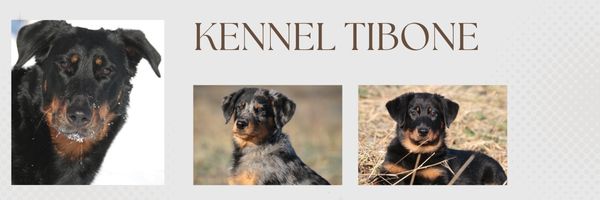

The beauceron is a rustic and resistant dog, the breed is little affected by health problems. The beauceron was originally a working dog and the dogs had to be able to work long hours in all weathers and dogs that were too weak or lacking adequate temperament were eliminated.
However, some health issues can occur and every serious breeder will have their reproducers tested to make sure that they only breed healthy dogs.
The health tests recommended by the OFA in collaboration with the American Breed Club are:
All my breeding stock is tested for hips, elbows, heart and eyes. I also have them tested for Von Willebrand's disease and degenerative myelopathy.
Hip dysplasia is an abnormal formation of the hip socket.
With cartilage damage or a hip joint that isn t formed properly, over time the existing cartilage will lose its thickness and elasticity. This breakdown of the cartilage will eventually result in pain with any joint movement.
Hip dysplasia is a genetic (polygenic) trait that is affected by environmental factors such as nutrition, exercise, early neutering, etc. It can also be caused by cartilage damage from a traumatic fracture.
Since it is a hereditary disease, it is important to select the reproducers carefully. To do this, it is essential to know the status of the hips of animals that we want to reproduce and the status of their predecessors ancestors and if possible of their relatives. The Orthopedic Foundation for Animals (O.F.A.) and the Pennsylvania Hip Improvement Program (PennHIP) are two organizations that evaluate, in their own way, the hips' integrity of reproductive subjects in America.
The radios are examined by 3 orthopedic veterinarians who evaluate the hips and assign a qualifier. There are 7 grades divided into 3 categories (normal, borderline, dysplasic)
Mild: Significant subluxation present where the ball is partially out of the socket causing an increased joint space. The socket is usually shallow only partially covering the ball. Moderate: The ball is barely seated into a shallow socket. There are secondary arthritic bone changes usually along the femoral neck and head (remodeling), acetabular rim changes (osteophytes or bone spurs) and various degrees of trabecular bone pattern changes (sclerosis). Severe: Marked evidence that hip dysplasia exists. Ball is partly or completely out of a shallow socket. Significant arthritic bone changes along the femoral neck and head and acetabular
PennHip is a unique method for measuring joint laxity of the hip. The method is quantitative (it gives a measure of angle), unlike other methods such as OFA that are qualitative or subjective (the orthopedist gives an assessment of the quality of the hip: excellent, good, etc.). The result of PennHip is a number between 0 and 1 (or more), the closer the angle is to 0 and the less there is laxity and therefore the risk of dysplasia is lower. A dog with a score of 0.3 or less is considered free from hip dysplasia.
There are two types of heart diseases : congenital cardiac disease and developmental cardiac disease.
Congenital heart disease in dogs is a malformation of the heart or great vessels that is present at birth and may develop more fully during perinatal and growth periods.
Developmental cardiac diseases develop later in life and include for example; hypertrophic, arrhythmogenic and dilatated cardiomyopathy.
Many congenital and developmental cardiac diseases may have a genetic component, however the exact modes of inheritance have not been precisely determined for all cardiovascular malformations.
I will talk here about the DCM because it's a disease that can affect the beauceron.
Dilated cardiomyopathy (DCM) is a disease of the heart muscle that is characterized by an enlarged heart that does not function properly. With DCM, both the upper and lower chambers of the heart become enlarged, with one side being more severely affected than the other. When the ventricle, or lower chamber, becomes enlarged, its ability to pump blood out into the lungs and body deteriorates. When the heart s ventricle does not pump enough blood into the lungs, fluid begins to accumulate in the lungs. An enlarged heart soon becomes overloaded, and this often leads to congestive heart failure (CHF).
DCM is an acquired disease, which means that it's not present at birth but develops during the life of the dog. It's recommended to have the reproducers tested every 2 years with an auscultation and Echocardiograms performed by a cardiologist.